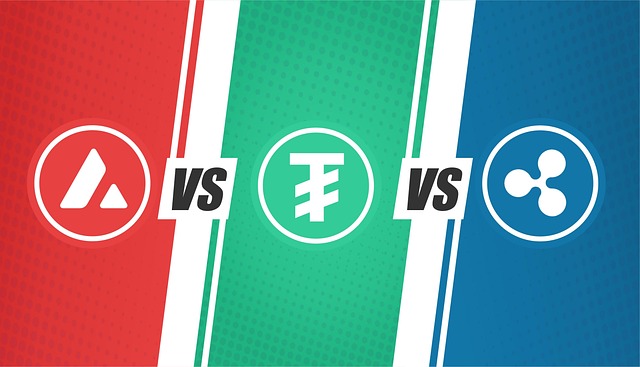Coingecko vs Coinmarketcap: Which Is Better?
Author: Jameson Richman Expert
Published On: 2025-08-13
Prepared by Jameson Richman and our team of experts with over a decade of experience in cryptocurrency and digital asset analysis. Learn more about us.
The ongoing debate between Coingecko vs Coinmarketcap remains a cornerstone discussion among cryptocurrency traders, investors, analysts, and researchers. Both platforms serve as essential tools, providing real-time market data, comprehensive analytics, and insights into the rapidly evolving digital asset landscape. As the crypto ecosystem expands—with innovations in DeFi, NFTs, Layer 1 solutions, cross-chain protocols, and institutional adoption—understanding the nuanced differences, strengths, and limitations of each platform becomes crucial for making informed trading strategies, portfolio management, and research decisions. This in-depth analysis explores their data coverage, accuracy, user interface, analytical tools, community engagement, and more, equipping you with the knowledge to select the platform that best fits your specific needs.

Introduction to Coingecko and Coinmarketcap
Founded in 2013, Coinmarketcap quickly established itself as the industry standard for tracking cryptocurrency market capitalizations, rankings, and exchange data. Its reputation as a reliable aggregator made it a go-to resource for traders, media outlets, and institutional investors worldwide. Coinmarketcap's focus has traditionally been on providing straightforward, transparent data on the largest cryptocurrencies, with an emphasis on market cap, trading volume, and liquidity metrics. Its user-friendly interface coupled with extensive exchange listings made it a staple for quick market overviews and comparative analysis.
Coingecko, launched in 2014, differentiated itself by emphasizing transparency, detailed project metrics, and broader data points—such as developer activity, social engagement, and community sentiment. Over the years, Coingecko has expanded its features to include DeFi analytics, NFT marketplace data, derivatives markets, and portfolio management tools, positioning itself as a more comprehensive ecosystem for crypto enthusiasts and professionals. Its emphasis on community-driven data and project health metrics has attracted a diverse user base interested in deeper project insights beyond surface-level prices.
While Coinmarketcap has historically concentrated on major cryptocurrencies and high-volume exchanges, Coingecko strives for a broader scope, including smaller, less liquid tokens, decentralized finance projects, and community-driven metrics. Recognizing these foundational differences helps users align their choice with strategic priorities—whether they seek broad project coverage or highly curated, high-confidence data on established assets.
Data Coverage and Cryptocurrency Listings
One of the most prominent differences between Coingecko vs Coinmarketcap lies in their depth and breadth of data coverage. Coingecko reports tracking over 10,000 cryptocurrencies across more than 600 exchanges, including decentralized exchanges (DEXs), Layer 2 solutions, and emerging blockchain projects. This extensive listing makes Coingecko invaluable for early-stage investors, DeFi enthusiasts, and those interested in discovering niche tokens, new DeFi protocols, or assets on less prominent chains like Solana, Avalanche, and Fantom. Its inclusion of tokens from various ecosystems provides a panoramic view of the entire crypto market.
Coinmarketcap, on the other hand, features approximately 2,500 cryptocurrencies, primarily focusing on the top 100–200 by market capitalization. Its listing criteria involve liquidity, trading volume, project transparency, and exchange verification, often excluding tokens with low trading volume or questionable legitimacy. This curated approach helps mitigate risks associated with scams, wash trading, and artificially inflated volumes—issues that have historically tarnished the reputation of lesser-known exchanges and tokens. The platform’s focus on high-confidence data is particularly valued among institutional and risk-averse investors.
For investors interested in early-stage projects, DeFi tokens, or initial coin offerings (ICOs), Coingecko’s broader and more inclusive dataset offers significant advantages. Its comprehensive coverage allows users to identify emerging trends and invest in tokens before they gain widespread recognition. Conversely, professional traders and institutional investors often prefer Coinmarketcap’s curated listings, which tend to offer higher data quality assurance and reduce exposure to dubious projects.
Market Data, Price Tracking, and Exchange Data
Both platforms provide real-time price quotes, historical charts, and trend analyses, but their data sourcing methodologies and update frequencies differ significantly. Coingecko aggregates data from over 400 exchanges, many of which are decentralized or smaller in scale, offering a decentralized view of prices. Its API pulls data frequently throughout the day, often updating every few seconds, which is advantageous during periods of high volatility or arbitrage opportunities. This rapid update cycle provides traders with near-instantaneous insights into market movements.
Coinmarketcap sources its data primarily from the largest, most reputable exchanges such as Binance, Coinbase, and Kraken, emphasizing high liquidity and trading volume. Its algorithms include measures to detect potential wash trading and exchange manipulation, but discrepancies can still occur, especially for tokens traded on low-volume or unverified platforms. The platform also employs a "conflict of interest" review process to validate exchange data, enhancing overall reliability for top-tier cryptocurrencies.
For traders engaged in arbitrage, cross-exchange analysis, or tracking minute-to-minute price trends, leveraging both platforms can provide a more comprehensive view. Coingecko’s inclusion of decentralized and emerging exchanges complements Coinmarketcap’s focus on liquidity and verified data, offering a balanced analytical toolkit for sophisticated traders and institutional analysts. Additionally, advanced traders often export data for custom analysis, and both platforms facilitate this with robust API offerings.

User Interface, Customization, and Accessibility
An intuitive user interface enhances data analysis and decision-making. Coingecko’s UI is known for its clean, customizable layout. Users can personalize dashboards, create watchlists, and compare multiple tokens side-by-side easily. Its detailed project pages include not only price and volume data but also developer activity, social media engagement, community metrics, liquidity, and DeFi integrations—making it especially popular among researchers, project analysts, and active traders seeking granular insights.
Coinmarketcap’s interface adopts a more straightforward, grid-based design that prioritizes quick access to rankings, trending assets, and exchange volumes. Its simplicity appeals to beginners or users seeking rapid snapshots rather than deep dives. Both platforms offer mobile apps optimized for on-the-go tracking, with Coingecko emphasizing in-depth customization options, including multiple layout configurations and alerts, whereas Coinmarketcap focuses on speed and ease of use for quick checks.
Additional Features and Analytical Tools
Beyond basic price and volume data, both platforms have developed advanced analytical features tailored to different user needs:
Coingecko’s Unique Offerings:
- Developer Activity Metrics: Track code commits, project updates, and GitHub activity to assess ongoing project health and developer engagement. This is critical for evaluating the longevity and vitality of crypto projects.
- Community Engagement Scores: Analyze social media metrics, Reddit activity, and sentiment analysis to gauge community support and hype cycles, helping investors identify trending assets or potential pump-and-dump schemes.
- DeFi & NFT Market Tracking: Offers dedicated dashboards for yield farming, liquidity pools, cross-chain DeFi projects, and NFT marketplaces, including floor prices, trading volumes, ownership distribution, and creator activity—providing a one-stop shop for digital asset ecosystems.
- Portfolio & Price Alerts: Users can set custom alerts based on price thresholds, portfolio value changes, or specific events, along with portfolio tracking tools that sync with multiple wallets, enabling real-time risk management.
Coinmarketcap’s Advanced Offerings:
- API & Institutional Tools: Provides enterprise-grade API access for quantitative trading, on-chain analysis, and custom integrations, suitable for hedge funds and algorithmic traders.
- Historical Snapshots & Data Backtesting: Access past data points, enabling backtesting strategies and analyzing historical trends for better predictive models.
- Derivatives & Futures Market Data: Offers detailed insights into futures, options, and leveraged trading, facilitating risk management and hedging strategies for professional traders.
- Exchange Verification & Security Assessments: Conducts thorough assessments of exchange security, KYC procedures, and compliance, helping users identify trustworthy trading venues.
For projects focusing on DeFi innovation, NFT markets, or on-chain analytics, Coingecko’s niche metrics provide unmatched depth. Conversely, professional traders and institutional investors leverage Coinmarketcap’s comprehensive data ecosystem and advanced API for algorithmic trading, portfolio optimization, and research.
Data Reliability, Validation, and Discrepancies
Accurate and trustworthy data is paramount in financial decision-making. Both platforms employ validation measures—such as cross-referencing multiple data sources, implementing anti-fraud algorithms, and encouraging community reporting. However, challenges remain, especially with low-volume tokens, wash trading, or exchange volume inflation.
Fake trading volume has historically been a problem in the crypto industry, artificially inflating metrics and misleading investors. Both platforms have taken steps to address this: Coinmarketcap employs exchange verification, volume reconciliation, and algorithmic detection of suspicious activity; Coingecko incorporates community feedback, third-party audits, and on-chain data verification to improve data accuracy. Still, caution is advised—users should corroborate data with on-chain analysis tools like Nansen, Glassnode, or Messari for added confidence. Blind reliance on any single data source can lead to misjudgments; cross-checking is essential for due diligence.
Regularly monitoring industry reports, community forums, and updates from trusted analytics firms helps identify anomalies or discrepancies before making significant investment decisions. Transparency about data sources and periodic audits by independent third parties further enhances credibility.

Integrations, APIs, and Affiliate Opportunities
Both platforms offer APIs for developers, traders, and institutions to integrate market data into their workflows. Coingecko’s API is praised for its extensive endpoints, ease of use, and free access, making it ideal for hobbyists, startups, and small-scale applications. It supports multiple programming languages and provides comprehensive data streams.
Coinmarketcap provides enterprise-grade API solutions with more extensive historical data, customizable requests, higher rate limits, and dedicated support—catering to institutional clients, hedge funds, and trading firms. Their API also supports multiple data types, including spot prices, derivatives, exchange statuses, and on-chain metrics.
Both platforms also have affiliate programs, incentivizing users to promote their platforms or associated exchanges. For example, Binance’s referral program offers commissions, trading fee discounts, and promotional tools. Such programs can be lucrative for content creators, community admins, and influencers looking to monetize their outreach efforts.
Which Platform Is Better for You?
The choice boils down to your specific objectives, risk appetite, and operational needs:
- For comprehensive research, project discovery, DeFi, and NFT insights: Coingecko’s broad coverage, community signals, and niche metrics provide a wealth of information suited for early-stage investors, hobbyists, and analysts seeking granular data on emerging projects.
- For high-liquidity trading, market cap rankings, and enterprise-grade data: Coinmarketcap’s vetted listings, focus on liquidity, and robust analytical tools are tailored for professional traders, fund managers, and institutional players.
- For developers, API consumers, and automation: Both platforms offer powerful APIs, but Coinmarketcap generally provides more extensive historical datasets and customization options suitable for quantitative analysis and algorithmic trading.
Final Thoughts
In conclusion, both Coingecko vs Coinmarketcap are indispensable in the modern crypto landscape. Their strengths are largely complementary—using both simultaneously provides a more comprehensive, cross-verified view, enhancing decision-making and risk management. Staying updated with new features, community insights, and industry trends ensures you leverage their full potential.
Engaging with community discussion forums like Reddit, Twitter, and specialized Telegram channels can provide additional macro and micro insights, often revealing market sentiment or emerging trends before they hit mainstream data feeds. For example, analyses like Reddit’s Bitcoin bottom discussions offer valuable context for macro timing and sentiment shifts.
Ultimately, successful crypto investing hinges on reliable data, continuous education, and strategic planning. Both Coingecko and Coinmarketcap are powerful allies—by leveraging their respective strengths, traders and investors can navigate the complex, volatile crypto markets more confidently and effectively.